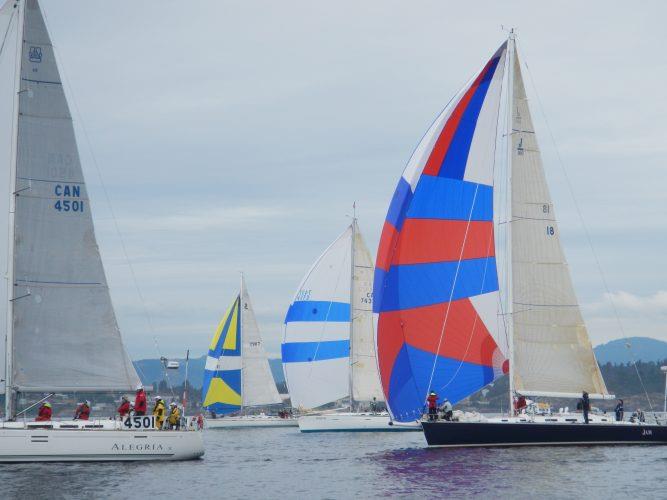
Lessons learned from our circumnavigation: Spinnaker vs. Twins
by Bill Norrie 14 Feb 2018 18:06 GMT

Racing fleet with spinnakers flying © Bill Norrie
Moving from coastal cruising to bluewater cruising one is faced with new sailing conditions.
Approximately 80% of most west-about tradewind sailing routes provide running and reaching conditions in steady 10-20kn breeze and 2 meter swells, day after day, with regular late afternoon and evening squalls. These squalls (20-35kn) arrive within 5 minutes and generally depart within 30 minutes. At least 40% of this downwind sailing is running with an apparent wind angle (AWA) of greater than 135 degrees, where the "twins" are an ideal rig. Above 135 AWA, reaching headsails and mainsail work well, as we are all familiar with from the coastal world.
Downwind coastal and racing fleets often hold the spinnaker and even a poleless gennaker in high regard. Wing-on wing, i.e. opposing mainsail to leeward and roller furling jib (RFJ) poled to windward, is another popular sail rig. In brisk breezes, a solitary leeward RF jib also works well.
The "Spinnaker Sock" has simplified and eased the physical work of hoisting and, especially, striking the unruly chute, but to bring the "Big Boy" under control by the usual "ma and pa" geriatric couple, or childbearing-age cruising crew on the high seas is the most common, dangerous sail trim maneuver.
The spinnaker or gennaker sock requires the foredeck crew to work with both hands above their head on the foredeck, while trimming the douser control lines. The spinnaker is an all or none sail. It functions only in a narrow breeze strength window of 6-15 true wind speed (TWS), and obviously it is not able to be flown in a reduced size. After dousing the chute, the sock then needs to be struck from the foredeck and mast position, which is also a two person job.
This situation has now been eclipsed by the combination of a 2.2 oz nylon drifter, with a spectra luff rope and continuous line furler (also called code zero furler). This 105% – 125% sized nylon sail (similar to the old-fashioned Genoa light air Dacron jib) is flown to leeward and twinned with the working Dacron RFJ poled to windward. The main sail is struck and under cover, with the boom secured and out of harms way. These twinned, furling headsails put the spinnaker or gennaker to bed. Hands down. No question.
Twins stabilize the boat with the centre of effort (COE) far forward with starboard and port forces equal. Most importantly, the twins are 100% titratable; i.e. easily furled down, even to bare poles, and then redeployed by one crew from the cockpit in all breeze strengths.
At zero knots, the sails are stabilized by the poles in the swells; at greater than 30 knots they would be completely furled and the vessel can run under bare poles. The pole or poles may be left up overnight and taken down the next day in daylight. Or the twins can be later unfurled to size, with diminishing breeze, day or night. The poles are far above the ocean swells, whereas the boom is vulnerable to catching the swell and breaking with the preventer deployed to protect the crew from the boom in an accidental jibe. The twin sail area changes can all be done by a solitary crew member in the security of the cockpit using the twin rig only.
The Volvo/Vendeé boats all use continuous line furlers (CLFs). The current 2017-2018 Volvo Race boats all show these (CLF) furlers at the jib tacks of every headsail they fly. The CLF twins allow a double-handed crew to regularly fly this rig into the night. The twins are beauty and function, at least in the view of the Terrwyn crew, co-skippers Cathy and Bill.
To read Jimmy Cornell and Brian Hancock promoting and selling their spinnakers to the average old cruising couple is disappointing to say the least. In our experience, few (~1/50) circumnavigating boats deploy a spinnaker at all and rarely at that. A spinnaker flown after dark in the open ocean by a double-handed husband and wife crew is definitely not recommended.
For those who are interested in hearing more, Terrwyn's expanded "Trade Wind Sailing" tactics and general sail plan is available on YouTube, including a 7 part lecture given to the Calgary Chapter, and multiple at-sea videos. I recommend "Sailing South of Madagascar" for our best 7 minute sailing video.
This article has been provided by the courtesy of Bluewater Cruising Association.